
Sicily boasts some of the most stunning landscapes and areas of outstanding natural beauty in the Mediterranean, including a great number of nature reserves, national parks and other natural attractions.
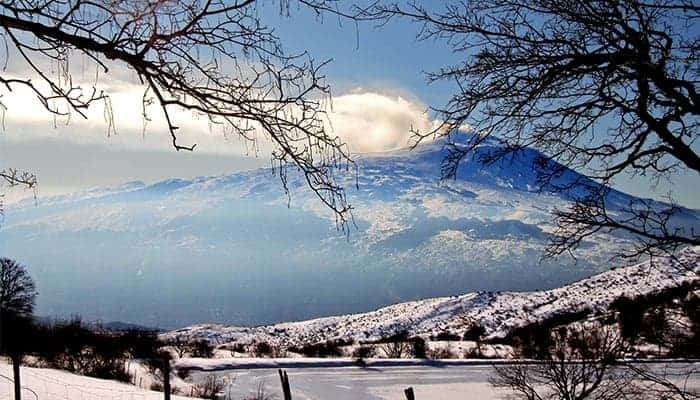
Mt Etna is the largest and most active volcano in Europe. The climb to the Station takes you through picturesque villages, particularly Linguaglossa and Nicolosi, depending on which route you choose, and an ever changing landscape. The lower slopes of the volcano are extremely fertile with groves of oranges, lemons and other Mediterranean flora and of course vines which produce Sicily’s best wines. Further up the slope you go through forests of chestnut trees which gradually give way to oak, beech, birch and pine – then you are above the tree line.
The summit of Etna is currently about 3,340 meters above sea level, currently because it increases with each new eruption. The last eruption, not a major one, was on 24th December 2018. Etna is forever smoking; the locals only worry when it stops smoking. There is no cause for concern and there are no surprises, this is the best monitored volcano in the world. Eruptions don’t just happen; they announce themselves, in Sicilian fashion, with little or no hurry.
Must do:
The climb to the Sylvester Crater is something one has to do at least once in a lifetime.
There are two ways of getting there, by cable car or for the young at heart – off-roading, bumpy but fun.
The panoramic view of the lush countryside with the Mediterranean majestically in the background is difficult to beat.
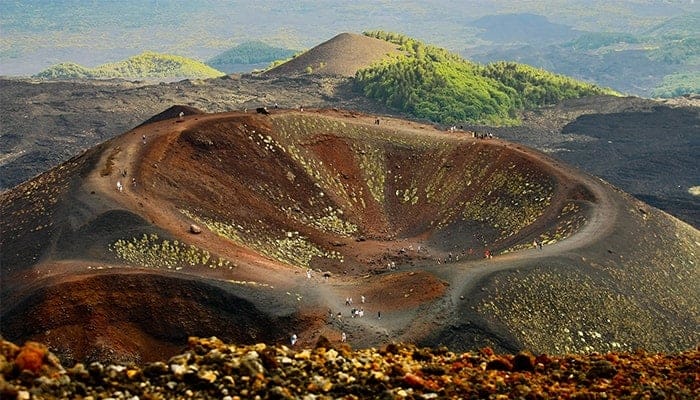
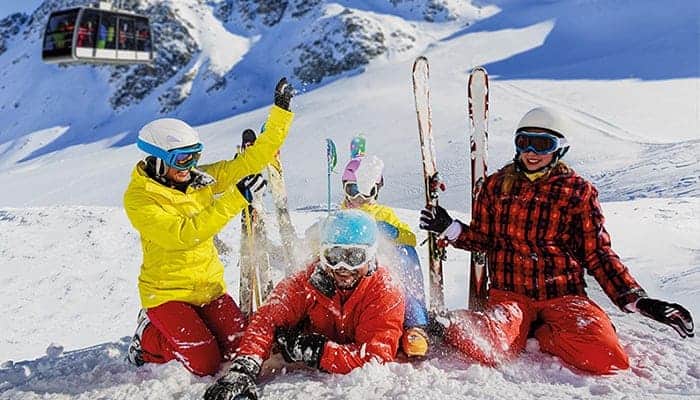
Can do:
Most commonly between December and mid-March – check on weather and snow conditions before departure.
The skiing slopes are between 1,800 and 2,600 meters. There are two main 'piste' one in the north that winds its way down from 2,300 meters to the picturesque town of Linguaglossa at 1,800 meters and the other, in the south of the mountain, makes its way from 2,600 meters to the enchanting little town of Nicolosi at 1,900 meters.
You will find all the standard skiing facilities, including ski rentals and ski-schools, nursery slopes for beginners and very importantly high-tech state of the art ski lifts.
This is great family fun, especially for the youngsters.
Gole dell’Alcantara is a gorge, a very particular sort of gorge. It was formed by the Alcanatara river cutting through crystallised volcanic rock from Mt Etna. The result is a natural display of scattered light as the rays of the sun bounce off in all directions from the multifaceted lava sides of the gorge. Adding to the excitement and adventure are the cold waters of the gorge.
The Alcantara river has its source near Foresta, the highest town in Sicily way up on the Nebrodi Mountains, about 1,300 meters above sea level. The melted snow of the Alcantara flows for 52 kilometers all the way down to the to the Ionian Sea at Giardini-Naxos at the foot of Taormina, hence the cold waters of the Gole.
This is well worth a visit. The Gole D’Alcantara is just 25 kilometres from Giardini Naxos, to put things in perspective, 35 minutes from Taormina and 80 minutes from Catania.
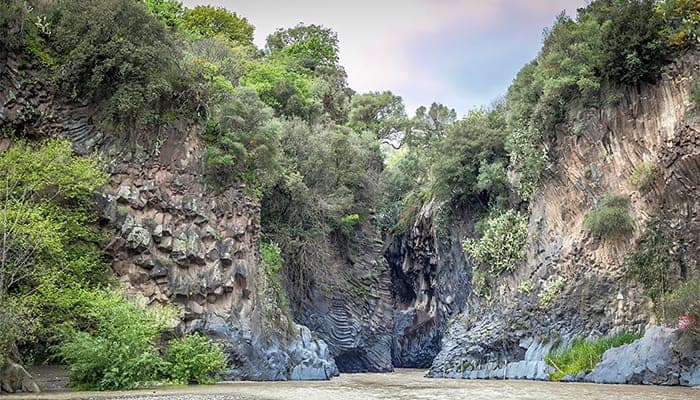
Roaming around the Madonie, what a joy.
The Madonie Mountains are the highest mountain range in Sicily. The highest mountain is Pizzo Carbonara at over 1,900 meters. Another five mountains are all over 1,500 meters with many more around the 1,000 mark.
This rugged countryside home to an absolutely fantastic array of Sicilian flora and fauna, many not to be seen anywhere on the island except here. You will come across some centuries-old maples, beech and ash to mention but a few. The mountain range is also home to the Madonie Regional Natural Park which stretches all the way from Palermo in the West to Cefalu in the North East, all of over 160 square kilometers of protected countryside.
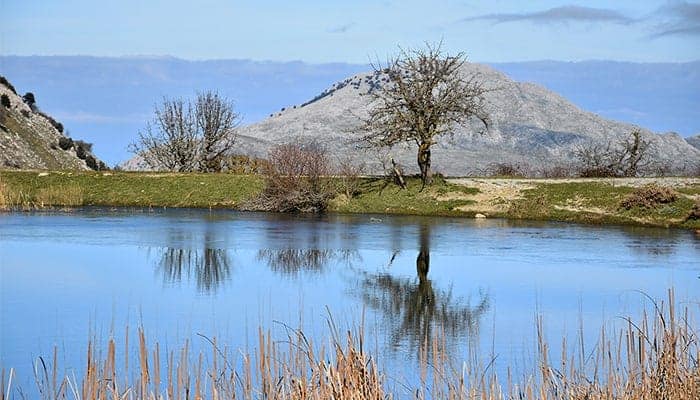
The area also features a good number of quaint medieval little towns, most within easy driving distance of each other. Don’t make the mistake of trying to drive to the centre of town, the narrow roads were not built for cars and in any case, you don’t need to – you are never far from the centre, even if you park out of town. Some wonderful churches, some you would think disproportionally large for the size of the town.
Lovely walks, lovely drives, an exceptional local cuisine, basted on local fresh produce and washed down with very nice local wine, go for the house wine, you will not be disappointed. In a nutshell – a lovely experience away from the hustle and bustle and one with nature.
If you leave the Parco at the East end don’t miss the opportunity to say hello to Cefalu.
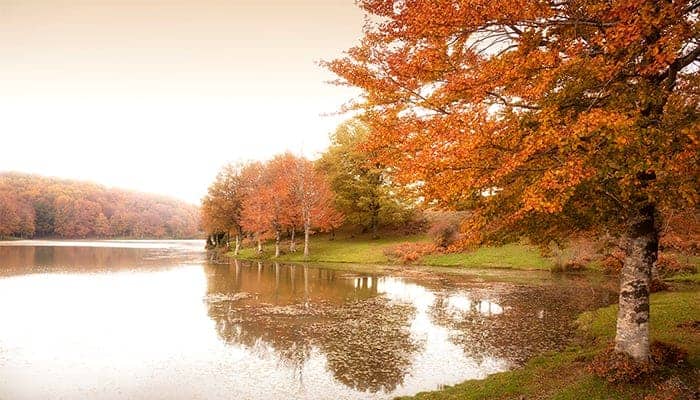
This mountain chain - part of the Sicilian Apennines (formed by both Madonie and Peloritans) - extends for about 70km parallel to the northern coast of the island. Marked characteristics of the natural landscape of the Nebrodi are the absence of symmetry between one face and another, the varied modelling of the mountains, the very rich vegetation and the humid environments. Some sites are particularly important because of peculiar features, constituting unique entities which are sometimes essential for the structure of the general geological and ecological balance: the Cesarò Biviere (pool), the Rocche del Crasto, Lake Trearie, the woods at Mistretta, Monte Pomiere, San Fratello and Mangalaviti are some of them.
The vegetation, which was one of the fundamental reasons for setting up the park, is extremely varied and divides into three different levels, as on Etna. The first, up to 1,000 metres, is subdivided into various bands: while the lower ones are cultivated, on the highest there are oak trees, cork oaks, euphorbias and turkey oaks. Turkey and ilex oak trees are also present on the successive level (up to 1,400m) together with beech trees. The latter go on up to the greatest height (Monte Soro, 1,847m). Lastly, there are maple trees, elms, then the yew, rarities in the Nebrodi. In the undergrowth there is holly, hawthorn, butcher's broom and other plants.